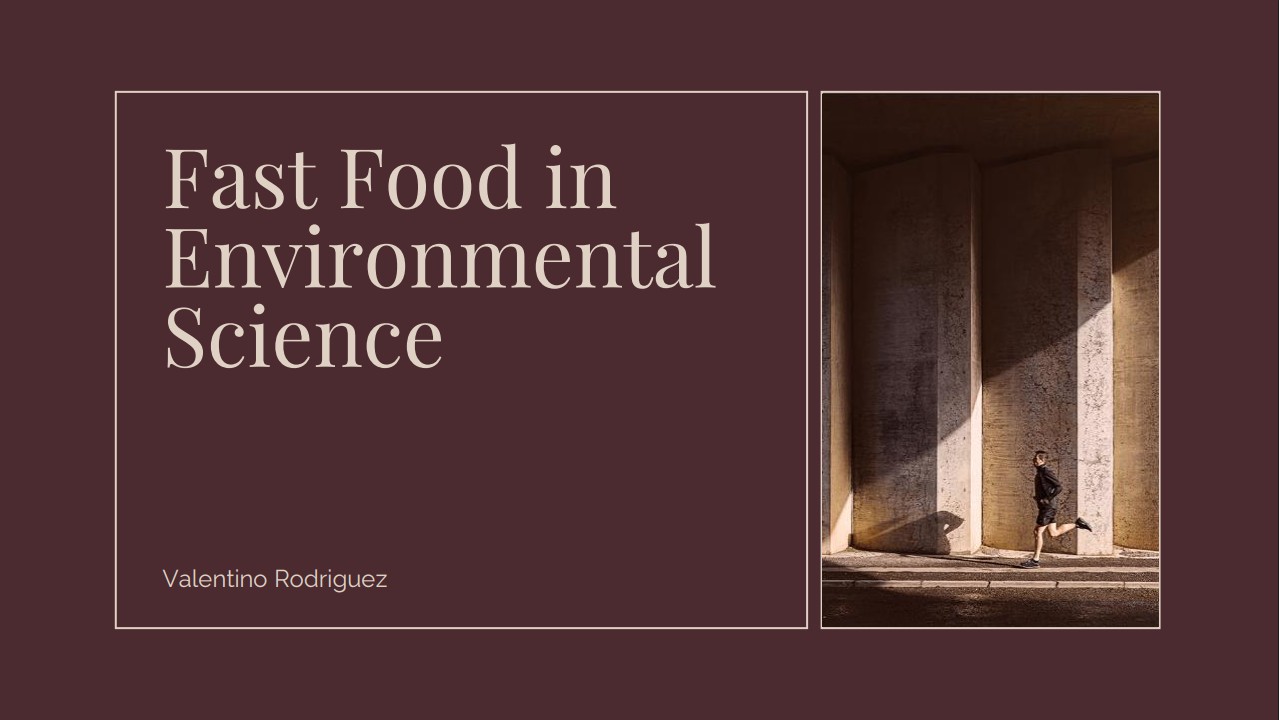Chapter Reflections

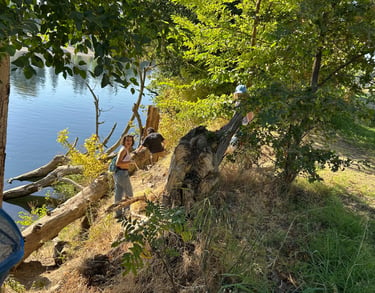
Photo by Dr. Garren
2. Chapter Reflections
2.1 Science and the Environment
(Chapter 1)
This first chapter provides a basic introduction to science and the environment through discussions on the state of the planet, sustainability, sound science, stewardship, and moving toward a sustainable future. It emphasizes the paradox of the state of the planet and how as humans have improved well-being while the natural ecosystem’s well-being has declined steadily.
The state of the planet follows four major global trends, human population and well-being, the status of vital ecosystem services, global climate change, and the loss of biodiversity. The world population has continued to grow at a rate of 80 million people per year. A major problem with this is that there is a population capacity for what this planet can support and we have already exceeded that capacity so as the population continues to grow, how long can the planet support human life and this growth? That brings up the idea of the vital ecosystem services and how we manage the natural ecosystems that support human life, especially as it grows at such a high rate, and currently, these resources are being severely mismanaged. Humans need the flow of goods and services from the ecosystem from water, food, shelter, fuel, to things such as the breakdown or waste, the climate, and nutrient cycles. These are the resources that human life requires and as the population grows, the resources available to each person decreases leading to a global environmental crisis. A major byproduct of human life and population is global climate change. The entire human economy runs off fuels that emit carbon dioxide which increases the pressure in the atmosphere and decreases the ozone layer leading to global warming and climate issues from the greenhouse gases, such as carbon dioxide, trapping heat. The final major global trend discussed here is the loss of biodiversity. Biodiversity is the variations of different organisms and the measure of different organisms in an ecosystem. As the human population grows and consumes more resources, it leads to overconsumption of resources and converting of forests and other environments into urban areas leading to the loss of many of the pants and animals that lived in those habitats contributing to the loss of biodiversity and many of the species.
This chapter also discusses the idea of sustainability, sound science, and stewardship. Sustainability is how a sustainable relationship between humans and the environment can be achieved to ensure a future balance and the goal of human interactions with nature. Sound science is our fundamental understanding of how the world works and how human systems interact with it. Stewardship is the actions and programs that manage natural resources and human well-being.
Sustainability comes with the idea of sustainable yields and how much of a resource can be harvested at a time without depleting the resources needed to keep producing the resource. It is the yield rate that can be continued indefinitely. A sustainable society is a society in balance with nature, or a society not exceeding its resource limitations. One concept that was especially interesting to me is the idea of sustainable development and how we can meet present needs without compromising future ones. This idea really stood out because it is challenging to drive anywhere and not see human development. Finding pure natural ecosystems is so rare now and that is unfortunately due to a lack of sustainable development.
Sound science is science that follows the scientific method and is legitimate science. The scientific method relies on observation, constructing models to better understand the observations and peoples understanding of the world from just their senses, experimentation to test a hypothesis or theory, hypothesis where we find questions to learn more about the world, and uncertainty and the understanding that there could be errors and the only way to confirm a hypothesis is to reject the null hypotheses and prove that the other explanations are false. The result of the sound science done is with theories and natural laws, both of which are the result of studies and work together to make up humans knowledge of the world. There is so much uncertainty with science that even with all of these tests, theories and laws can be proved wrong by future scientists or be disagreed on within the scientific community with the introduction of new information, a complex phenomenon, a variety of different perspectives, and each scientist’s individual bias. There is also a lot of junk science presented to the community which is not scientifically valid but is promoted to get people talking or motivate them to do something.
Stewardship is how people protect and sustain the environment through different environmental protection movements from recycling efforts, cleanups, sharing information, and protesting policies. Another form of stewardship is through justice and equity and fair relationships among humans with regards to access to resources and the placement of hazardous industries. Many are located in racially discriminatory ways and a form of stewardship is working to stop those practices and promote the equitable allocation of resources.
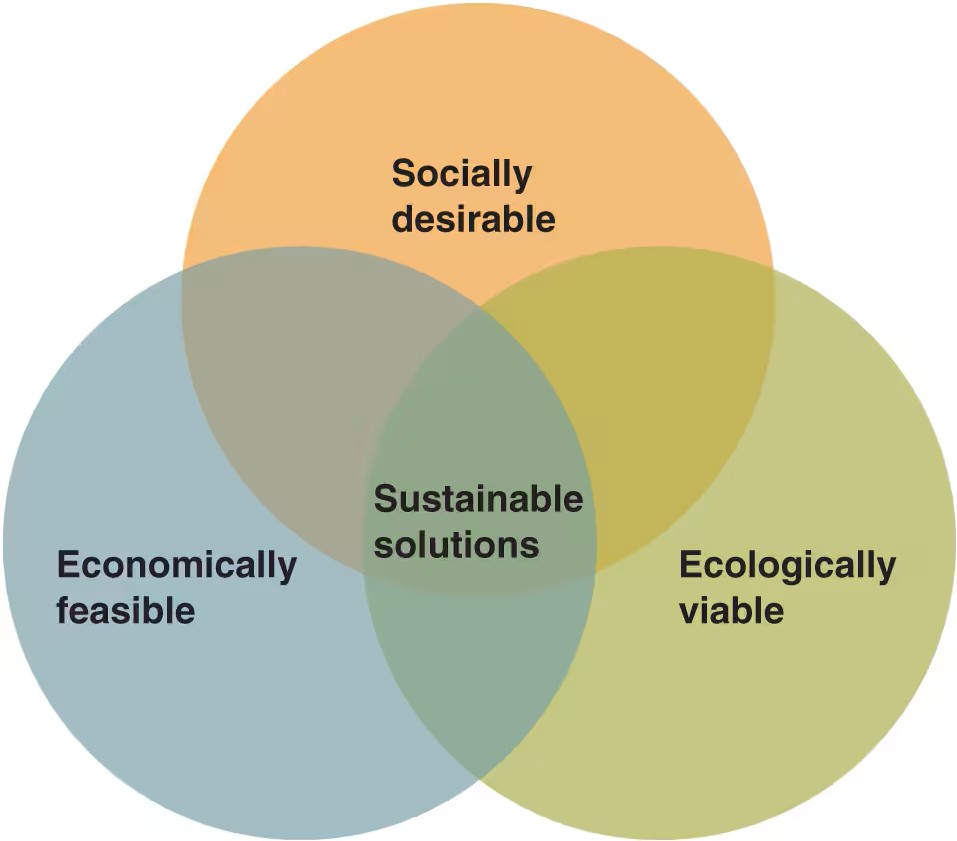

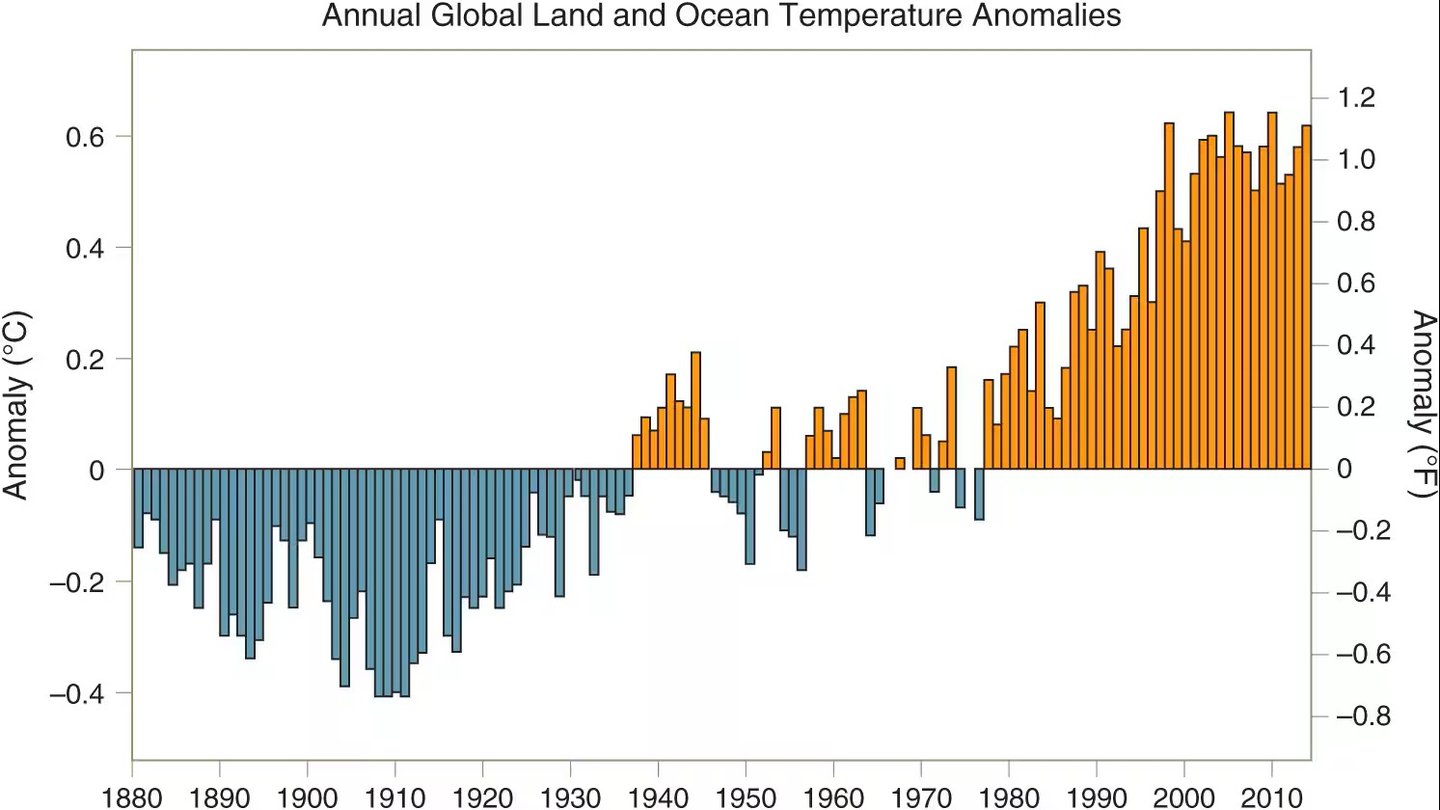

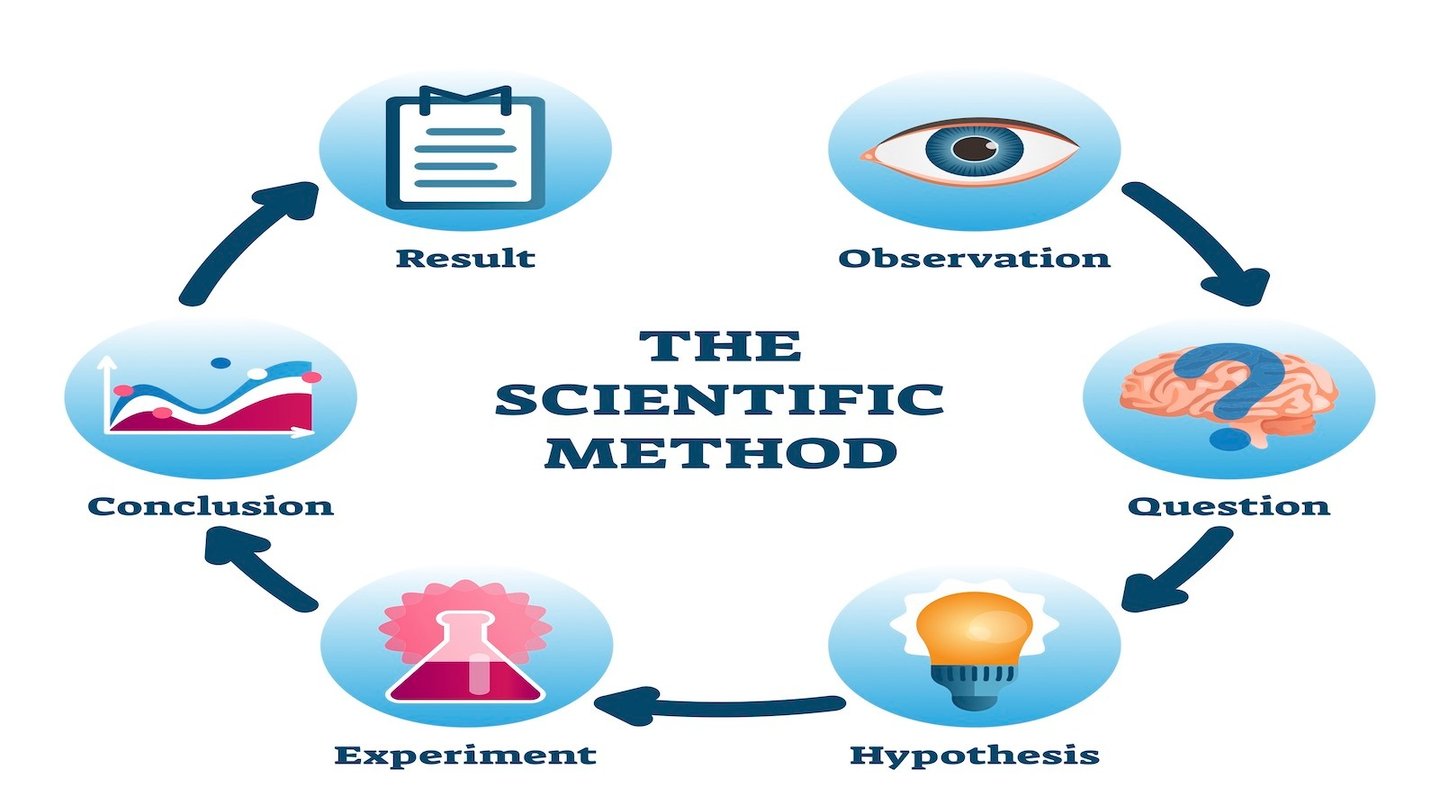





Mastering Assignments Report
The above images show my results on the homework assignments and quiz for this chapter. Here you can see I got 100% on both showing my knowledge in the material covered in this chapter, specifically with science and technology within a society, interpreting graphs and data, and the process of science for sustainable solutions. I did work through the quiz twice to practice and ensure full understanding of the content.
Wright, Richard T., and Dorothy F. Boorse. Environmental Science toward a Sustainable Future. 13th ed., MTM, 2017.
Wright, Richard T., and Dorothy F. Boorse. Environmental Science toward a Sustainable Future. 13th ed., MTM, 2017.
“The Scientific Method Is a Process for Experimentation.” Australian Environmental Education, 8 Nov. 2020, www.australianenvironmentaleducation.com.au/education-resources/what-is-the-scientific-method/. Accessed 07 Oct. 2025.
“Environmental Stewardship / City of St. Albert.” City of St. Albert, stalbert.ca/cosa/admin/statracker/environment/. Accessed 07 Oct. 2025.
2.2 Economics, Politics, and Public Policy
(Chapter 2)
This chapter was on economics, politics, and public policy. It discusses how economics relates to the environmental goods and services, the resources and as wealth in a sustainable society, ethics with regards to the environment and economy, environmental public policy and the cost-benefit analysis of those policies and getting society to agree on a policy. There is a constant conflict between economics and environmentalism since to grow quickly economically usually has a high environmental cost such as in China and how the economic growth lead to extraordinarily high pollution and toxic air.
Economics deals with the production, consumption, and distribution of goods and services. This chapter discovers the relationship between economics and the environment and the cost of economic activity. Producing and distributing goods often produces a lot of carbon dioxide and significantly. The three factors of production are land, labor, and capital and land is a major environmental cost. With rapid economic growth causing pollution, it has become more noticeably necessary to create a sustainable economy rather than one that is depleting its resources and leading to pollution, global warming, rising sea levels, and loss of biodiversity. There needs to be a transition from a brown economy to a green one. More environmental costs are the materials and energy used, the ecosystem services, and the production of heat energy and waste.
A nation’s wealth is measured in produced capital (goods and services), natural capital (natural resources), and intangible capital (skills, culture, and knowledge). It is measured in a gross national product which is the sum of all of those types of capital in a country but some things such as farming in developing countries are not measured leading to inaccurate measurements of the natural services provided by the ecosystems and also does not account for the depreciation of natural capital. There are other ways of measuring the wealth of a country, but all are flawed in one way or another and the GDP is the most commonly used one.
Another misconception is that having natural capital means it’s distributed among everyone in a society. Those in rural poverty usually live in more polluted areas near hazardous plants and often can not afford many of the quality natural resources due to the high cost. In fact, many farmers in Guatemala grow food that they cannot afford to eat. The resources also need to be managed to not only support the well being of current people but also of future generations. Another main issue is waste. In the US about 40% of the food produced is thrown away. There are laws requiring food to be thrown out once served at restaurants even if never touched.
The legislative branch is responsible for establishing laws and policies and Congress has the responsibility to enforce environmental public-policy laws. They have made a variety of regulations to regulate pollution, and polluters are required to meet those requirements. There are also market based policies where polluters can make their own environmental standards with a market-based approach and there are incentives to lower pollution. Policies must go through 4 stages, recognition of the issue, formulation of the policy, implementation, and control. Policies also go under a cost-benefit analysis where the need for the regulation is examined, and then alternative approaches considered and the estimated cost of the different approaches to decide whether or not the policy would be implemented. Policy makers do not often consider the cost of a policy completely nor do they consider the cost of doing nothing. Then comes the biggest challenge of actually getting society to agree on and pass a policy. Environmental concerns are often battles between a variety of special interest groups with different opinions on how to solve the problems.
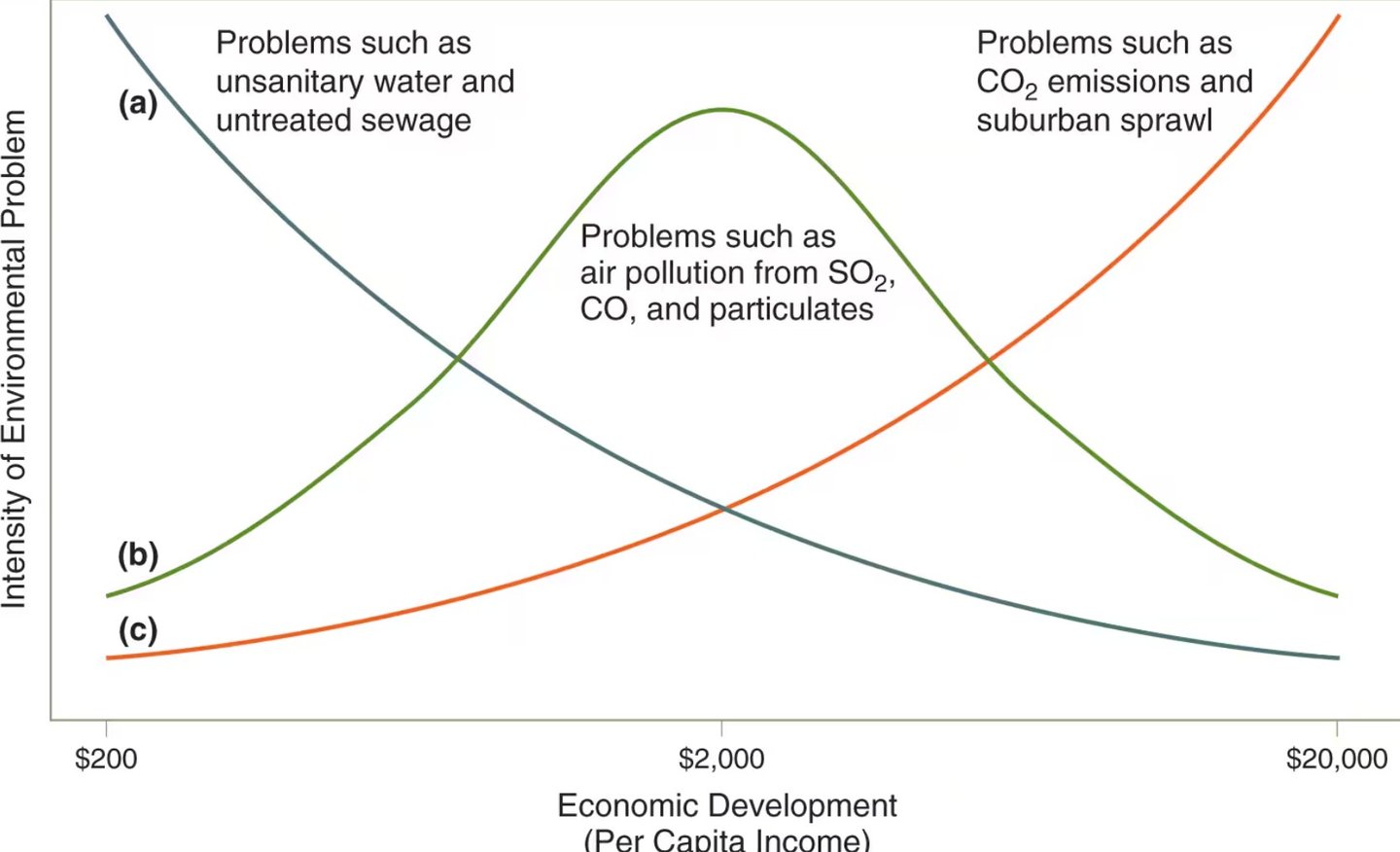


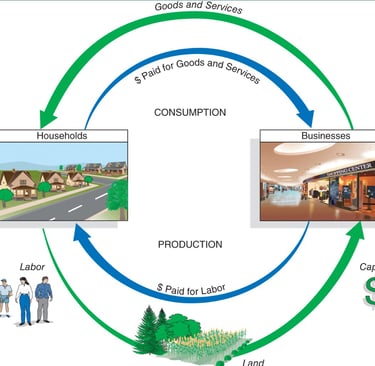
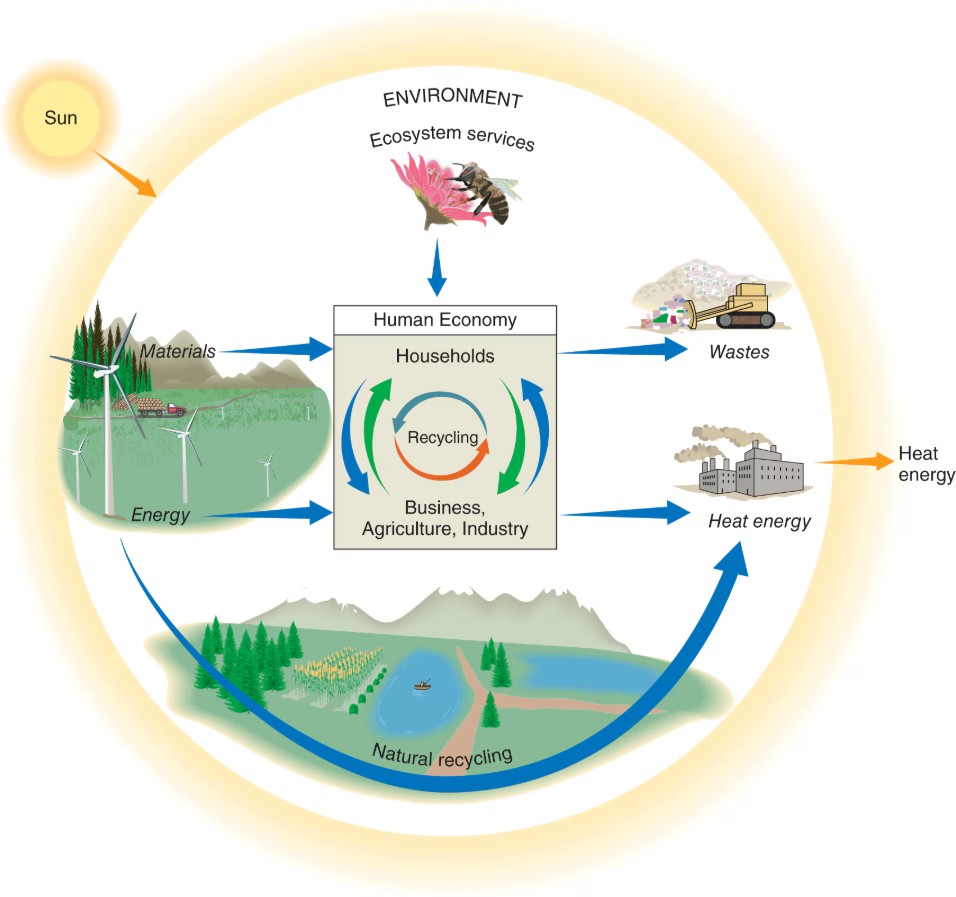

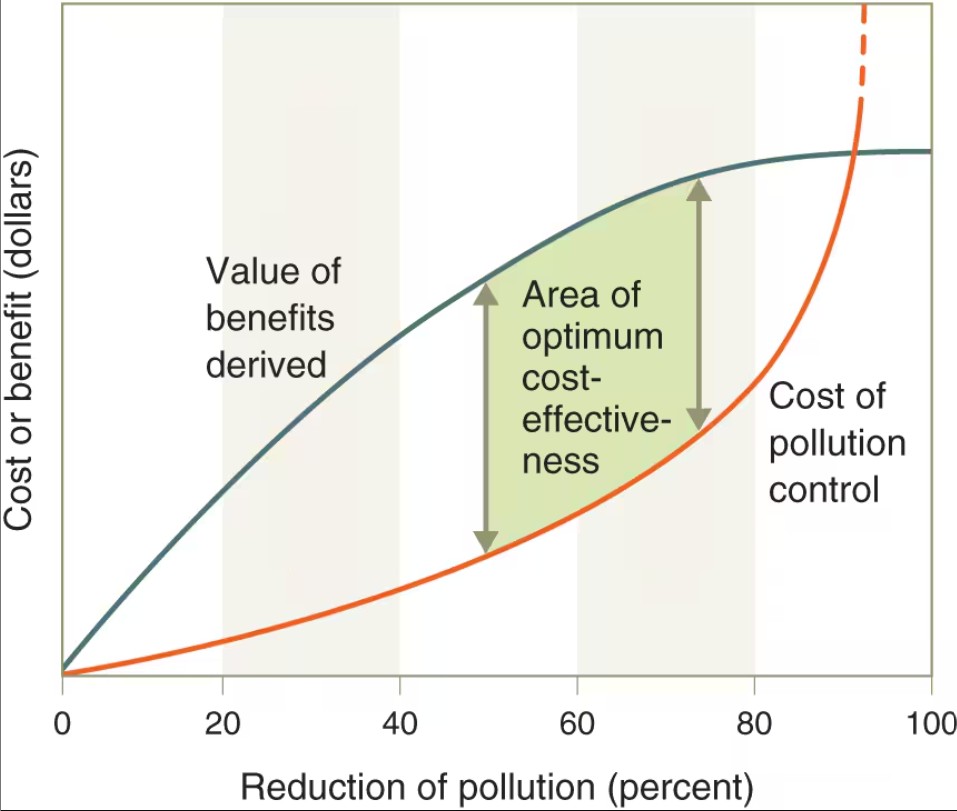


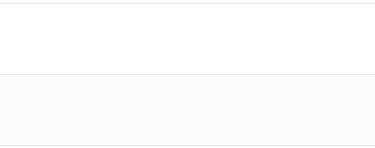


The above images show my results on the homework assignments and quiz for this chapter. Here I did miss some topics on the homework assignment but I was able to learn them fully before the quiz. Here I excelled at GDP and GPI, supply and demand, and the tragedy of the commons and red deer in Spain and had to work on environmental policy and the economy and the environment sections. I did work through the quiz twice to practice and ensure full understanding of the content.
Mastering Assignments Report
Wright, Richard T., and Dorothy F. Boorse. Environmental Science toward a Sustainable Future. 13th ed., MTM, 2017.
Wright, Richard T., and Dorothy F. Boorse. Environmental Science toward a Sustainable Future. 13th ed., MTM, 2017.
Wright, Richard T., and Dorothy F. Boorse. Environmental Science toward a Sustainable Future. 13th ed., MTM, 2017.
Wright, Richard T., and Dorothy F. Boorse. Environmental Science toward a Sustainable Future. 13th ed., MTM, 2017.
2.3 Basic Needs of Living Things
(Chapter 3)
Chapter three explores the basic needs of living things with topics like organisms in their environment, environmental factors, matter in living and nonliving systems, matter and energy, and the cycling matter in ecosystems.
Ecology is the study of all of the processes influencing the abundance of organisms and their distribution and how living things interact with their environment. Each community is represented by a population within a species. This population is part of the species in the area that make up the reproducing group. Biotic communities are all types of organisms that live in an area. An ecosystem is an interaction of different communities and the environment affecting them in an area. A landscape is a cluster of ecosystems, and a biome is a large area of Earth’s surface that shares a similar climate and vegetation. A biosphere is the interconnection of all of the ecosystems on earth.
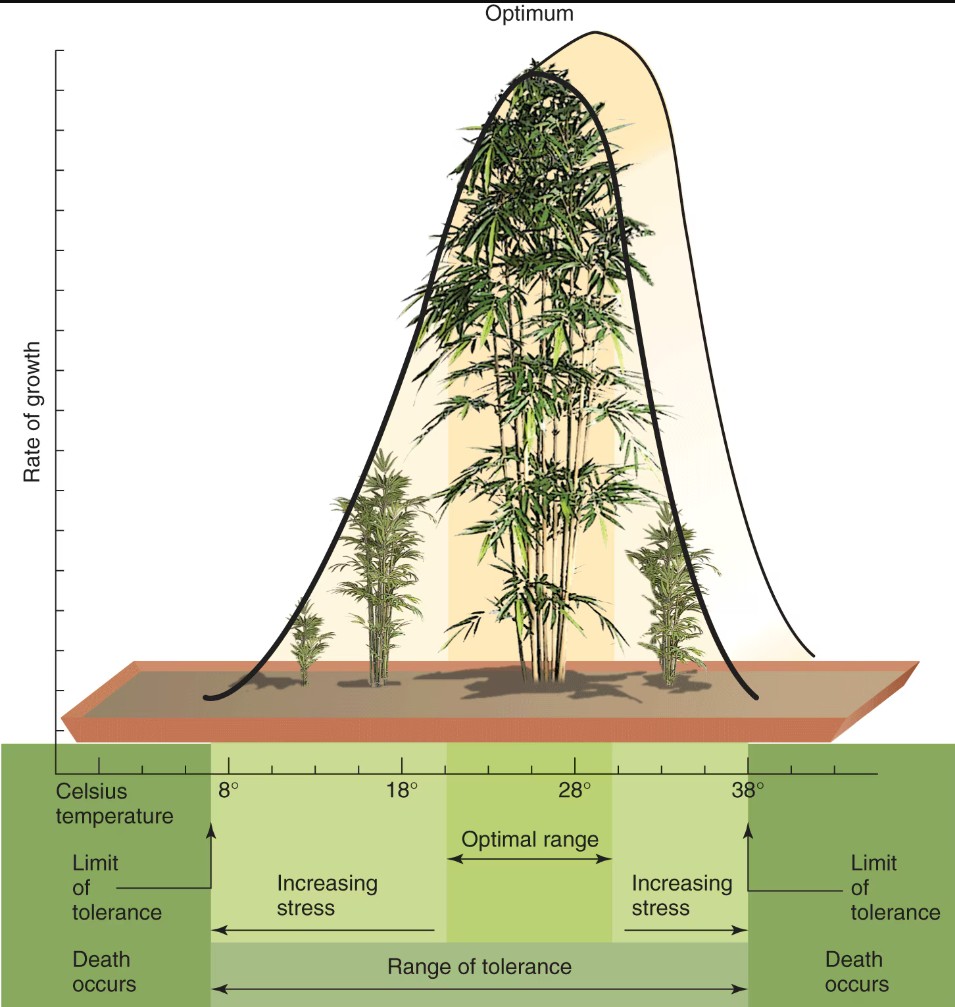

Different kinds of species thrive in different environments with different climates, resources, and other factors. The range of tolerance is the entire span that allows any growth of an organism. The limits of tolerance are the high and low endpoints of that curve. And the zones under the curve bout outside of the optimal range are called zones of stress. There is a law of limiting factors in an environment. A limiting factor is a factor that limits growth. The law of limiting factors is when any factor is outside of the optimal range, it will cause stress and will limit the growth and survival of a population. A limiting factor can be too much of a factor or too little.
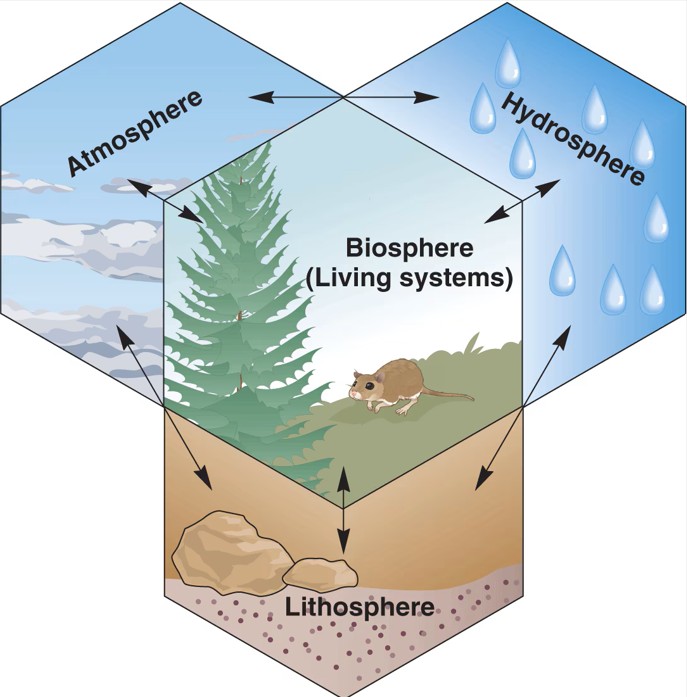

Matter is anything that has mass or takes space and is made up of atoms. The different structures of atoms found in nature are called elements. The law of Conservation of Matter says that matter is never lost, only transferred between forms and organisms. Molecules and compounds are combinations of at least two atoms and compounds are at least two different kinds of atoms. Earth’s environment is made of these molecules and compounds and can be separated into 4 spheres, the atmosphere, hydrosphere, lithosphere, and biosphere. The atmosphere is a mixture of oxygen, nitrogen, and carbon dioxide, the hydrosphere is a source of carbon, oxygen, and hydrogen. The lithosphere is a source of minerals and crystals. All of the different spheres interact and pass the different elements back and forth in different forms.

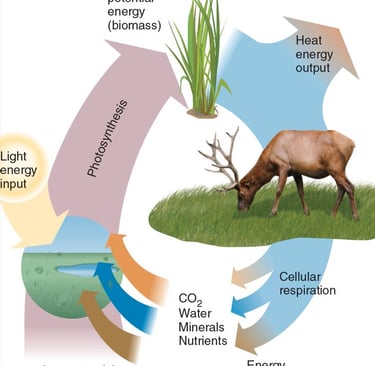
Energy, in the most basic definition, is the ability to move matter. There is kinetic energy, energy in motion, and potential energy, energy in storage. Those are the two most well-known, but there is also chemical energy. Energy can be transferred between forms and converted from one type to another but the Law of Conservation of Energy states that energy is never created or destroyed. Producers gain energy through photosynthesis and transforming sunlight into energy they can use and consumers gain energy for movement and growth from consuming producers or other consumers and absorbing and breaking down their organic matter. Energy flows one way in an ecosystem in a circular matter through consumers, producers, and decomposers.
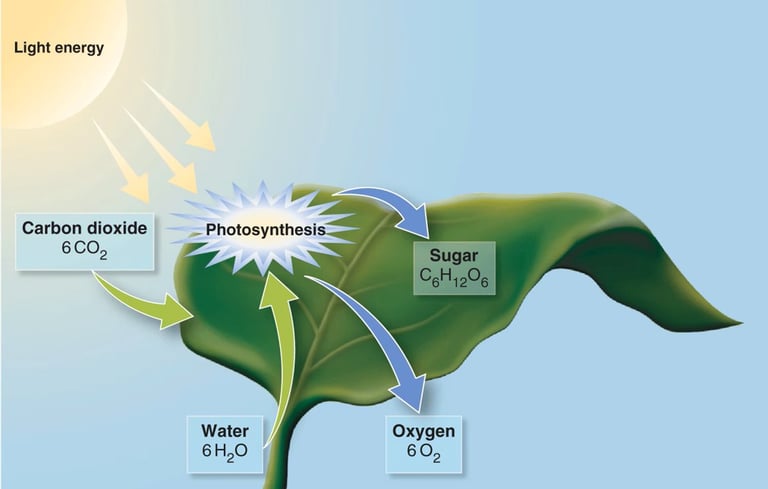


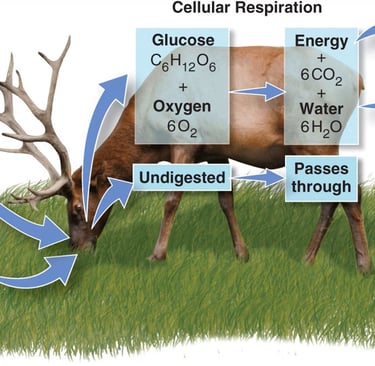
Some important cycles in the ecosystems are carbon, phosphorous, nitrogen, and sulfur. These cycles will be further explained in the worksheet below, but they are all one-directional cycles and interact with each other. All four cycles are critical to the environment and have human and pollution impacts.
Biogeochemical Cycle Activity


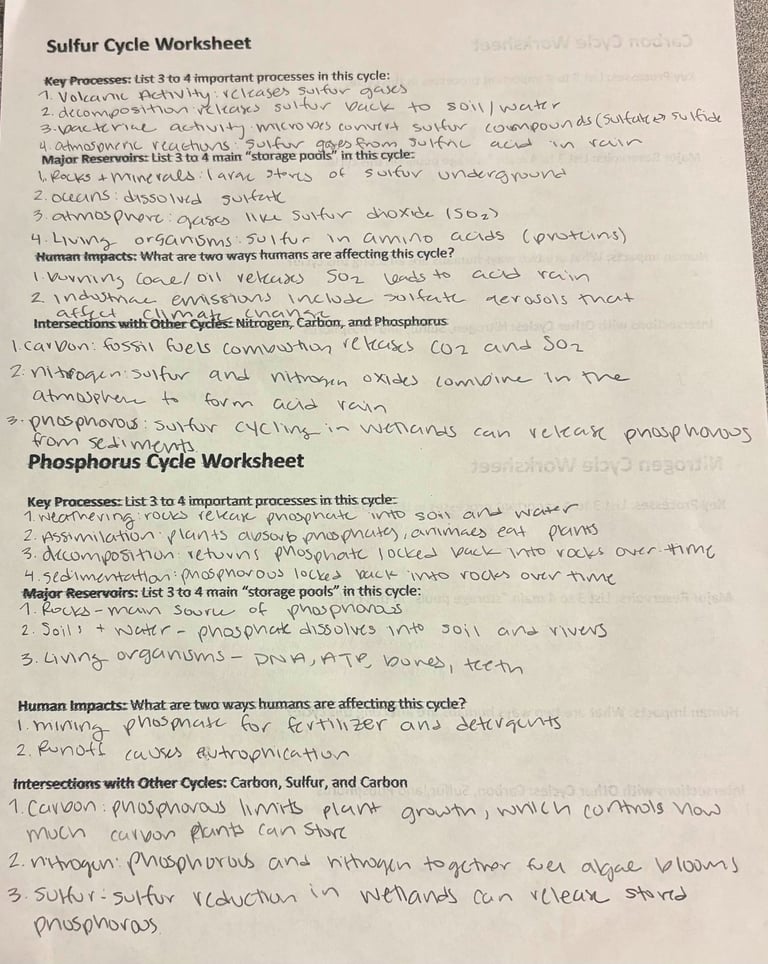

The above images show the worksheets discussing the processes, storage pools, human impacts, and intersections with other cycles for the Carbon, Nitrogen, Sulfur, and Phosphorous cycles. We did an activity in class where we got into groups and learned one of the cycles really well and then sent ambassadors to the other groups to learn about their cycles while we taught the other groups ambassadors about ours. Then our group came back together and the ambassadors shared the information with the group about the cycle they just learned. It was very interesting to see how each of the cycles were connected and how they amplified each others pollution impacts.
Mastering Assignments Report


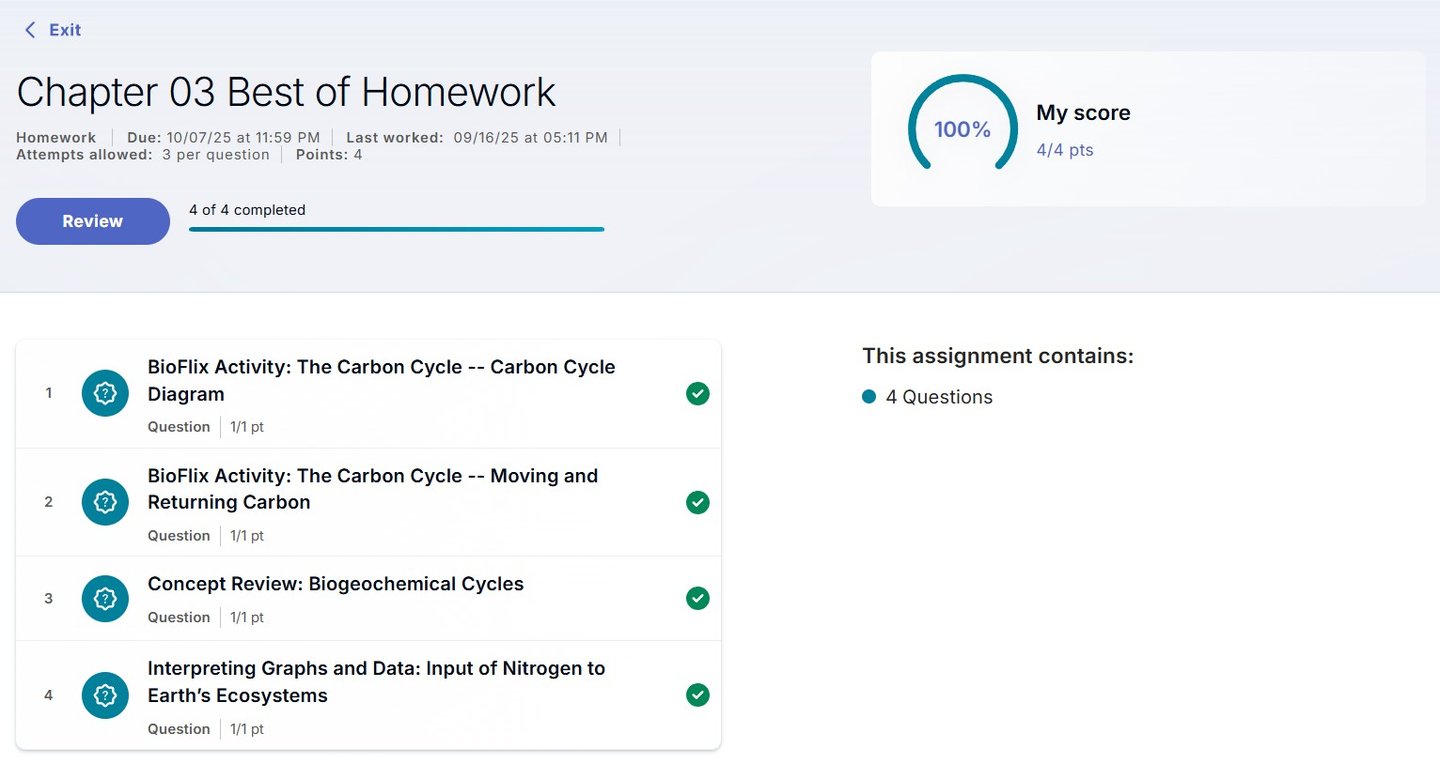

The above images show my results on the homework assignments and quiz for this chapter. Here you can see I got 100% on both showing my knowledge in the material covered in this chapter, specifically with the carbon cycle, biogeochemical cycles, and the input of nitrogen to Earth's ecosystem. I did work through the quiz three times to practice and ensure full understanding of the content.
Wright, Richard T., and Dorothy F. Boorse. Environmental Science toward a Sustainable Future. 13th ed., MTM, 2017.
Wright, Richard T., and Dorothy F. Boorse. Environmental Science toward a Sustainable Future. 13th ed., MTM, 2017.
Wright, Richard T., and Dorothy F. Boorse. Environmental Science toward a Sustainable Future. 13th ed., MTM, 2017.
Wright, Richard T., and Dorothy F. Boorse. Environmental Science toward a Sustainable Future. 13th ed., MTM, 2017.
2.4 Populations and Communities
(Chapter 4)
Chapter 4 discusses populations and communities and the dynamics of natural populations, limits on populations, community interactions, evolution as a force of change, and implications for management by humans.
The members of each species in a certain ecosystem and reproducing group in an area make up the population and the different populations of the different species in the area make up a community. Populations change depending on different factors and scientists like to track the births and deaths in a population to track the change in the numbers of individuals in a population. Population growth is the measure of the change in the size of a population and can be calculated using the equation:
change in population growth = (births + immigration) - (deaths + emigration).
If there is no change or very little change in the population size, then the population is in equilibrium. The population growth rate can be found by finding the change in population growth and dividing it by the change in time. In a natural environment, the growth of a population can follows a constant rate, a j-curve, or an s-curve seen in the graph below. A population carrying capacity varies based on different conditions. Favorable conditions could lead to an increase in carrying capacity and a decrease in less favorable conditions. There are even cases of exponential increase in the carrying capacity and super-fast and big growths are called population explosions – represented by the J-curve. The biotic potential of a species is the rate at which members of a species reproduce when under unlimited conditions. There are different kinds of reproductive strategies. R-strategists have a short lifespan and very high reproduction rate. K-strategists have a much lower reproductive rate but they care for their young until their young are old enough to compete.
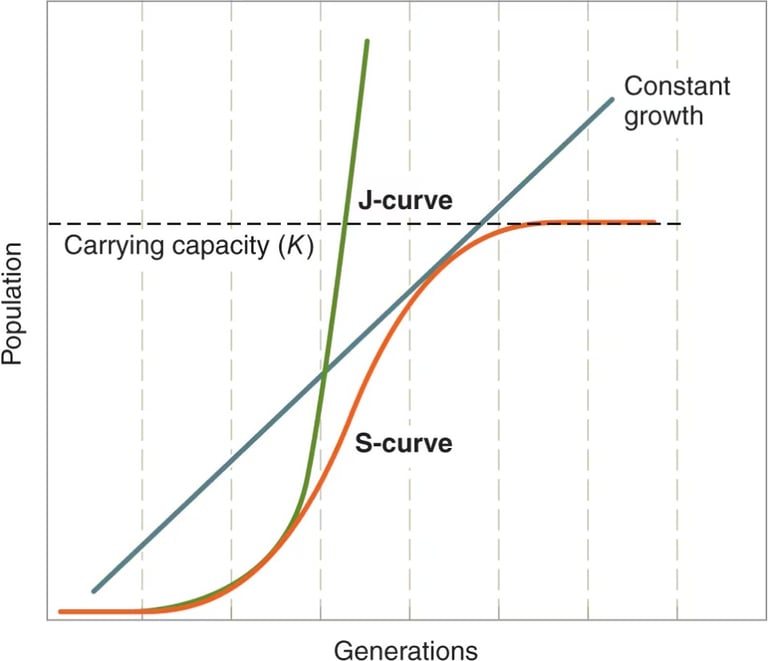



The carrying capacity of an area is how big a population can be sustained based on the limiting factors. These limiting factors play a much greater role where there is a higher population density. Density-dependent limitations are when the population that can be sustained of one species is dependent on the population of another species. A populations critical number is the minimum population base for survival.
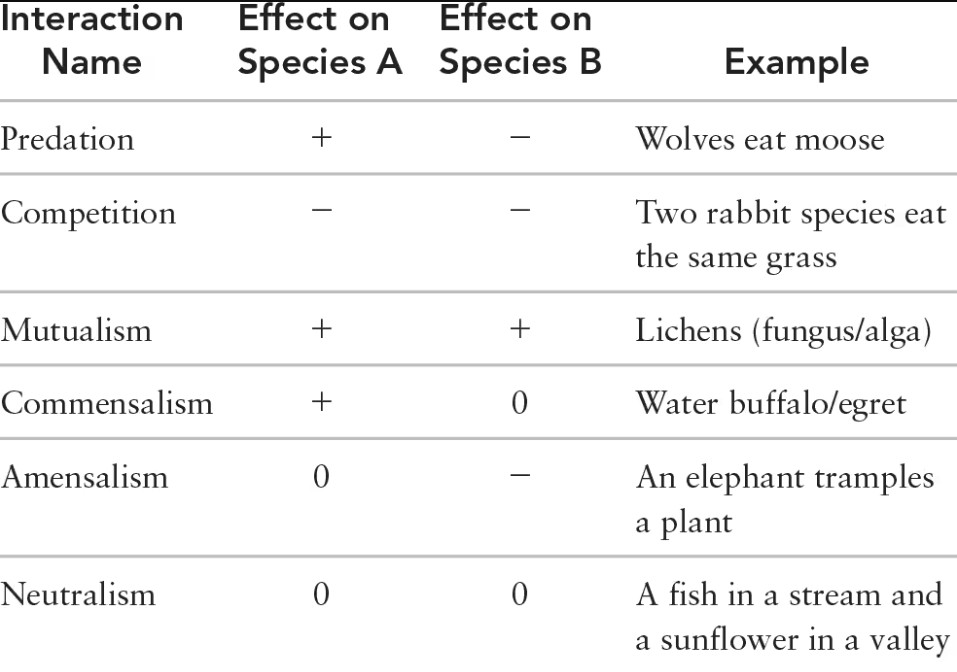

There are many different community interactions within species such as a symbiotic one, where the species are closely connected. There are predation relations where one species benefits and the other is harmed such as parasitism, herbivory, and carnivory. Competition is the relationship between two species that rely on the same resource and mutualism is where both species benefit from each other. There is also commensalism where one species benefits and the other is unaffected and amensalism where one species is harmed and the other is unaffected. Keystone species are critical to the survival of an ecosystem but each of these relationships affect the populations and population growth of the species involved.

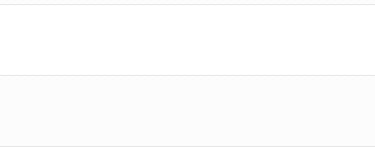
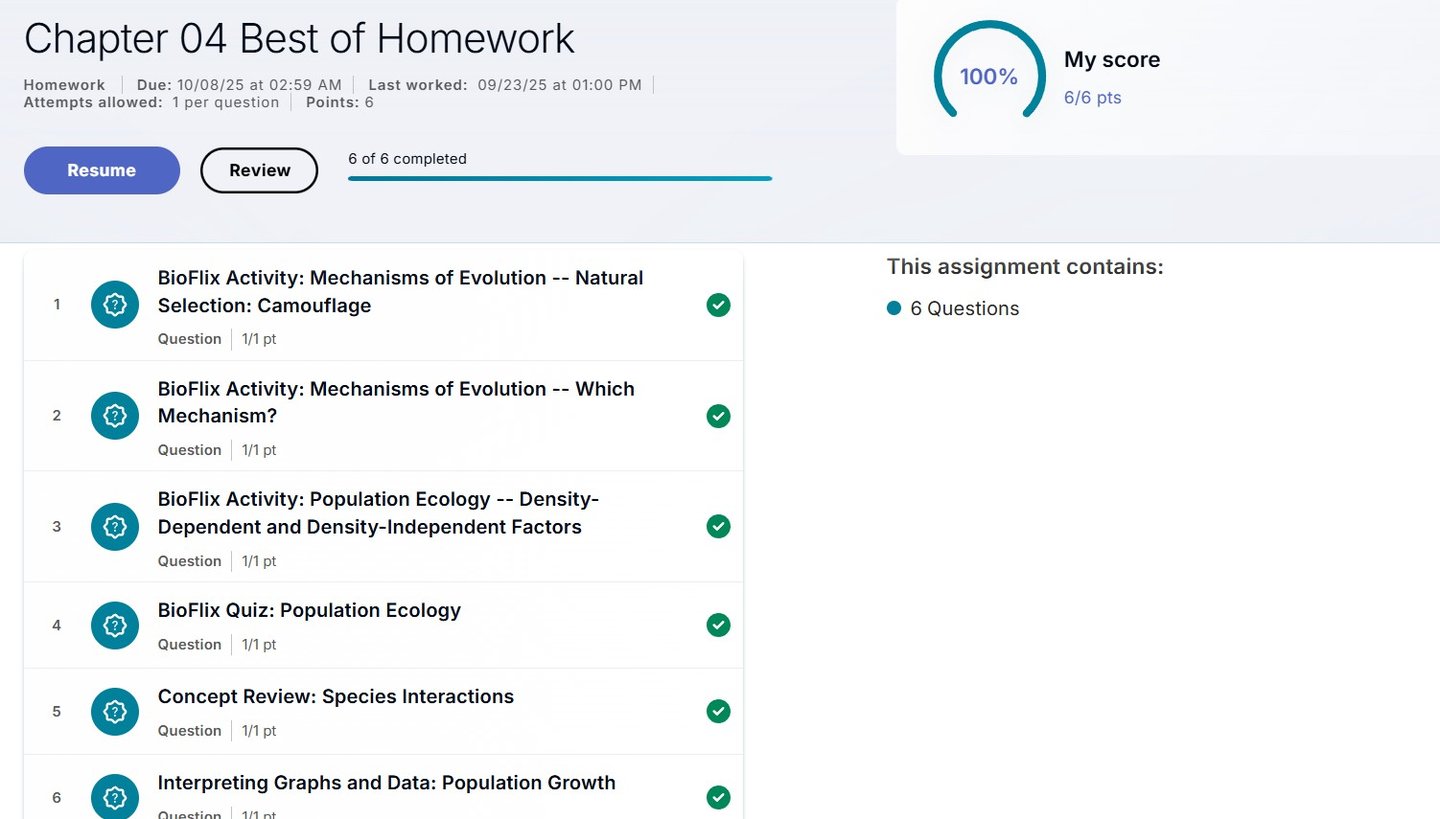

The above images show my results on the homework assignments and quiz for this chapter. Here you can see I got 100% on both showing my knowledge in the material covered in this chapter, specifically with natural selection, mechanisms of evolution, population ecology, species interactions, and population growth. I did work through the quiz three times to practice and ensure full understanding of the content.
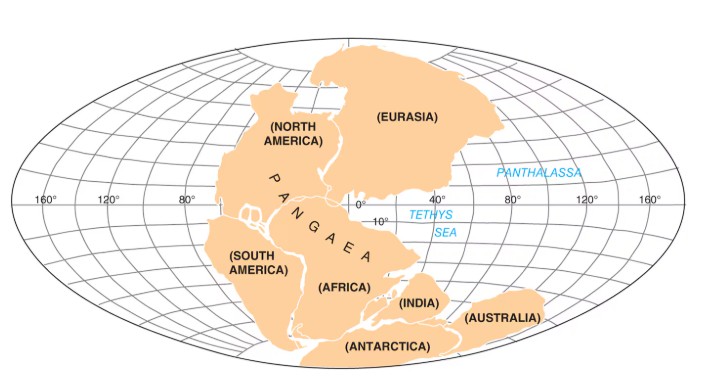



There are pressures in an environment that cause some individuals to survive and reproduce and others to be eliminated. Those with the traits that allow them to survive and reproduce more with those beneficial traits, this is called natural selection and plays a major role in biological evolution. Organisms must adapt to their environment for survival of the species and those with better traits will pass those on. A change in an environment can lead to one of three outcomes for a species, adaptation, migration, or extinction. Some key factors to a species’ survival are geographical distribution, specialization to habit and food supply, genetic variation, and the reproductive rate. The different zoogeographic regions are a result of plate tectonics causing continental drift and the separation of Pangea. His separation led to an increase in biodiversity and different habitats on the different continents.
Humans also have a large impact on biodiversity and ecosystems by introducing invasive species and exporting problems that have a major impact on the structure of the different ecosystems.
Wright, Richard T., and Dorothy F. Boorse. Environmental Science toward a Sustainable Future. 13th ed., MTM, 2017.
Wright, Richard T., and Dorothy F. Boorse. Environmental Science toward a Sustainable Future. 13th ed., MTM, 2017.
Wright, Richard T., and Dorothy F. Boorse. Environmental Science toward a Sustainable Future. 13th ed., MTM, 2017.
2.5 Ecosystems and Biodiversity
(Chapters 5 & 6)
The above images show my results on the quiz for this chapter. Here you can see I got 100% on the chapter 5 & 6 quiz showing my knowledge in the material covered in this chapter, with ecosystems and biodiversity. I did work through the quiz two times to practice and ensure full understanding of the content.



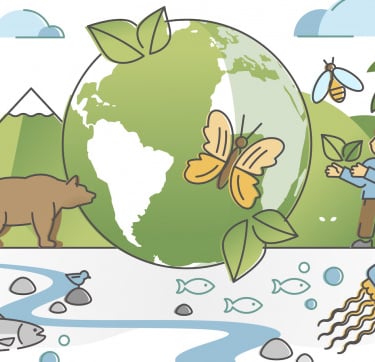
Energy Transfer frows through ecosystems in one direction from the sun to the producers to the consumers and then to the decomposers. These are the same categories that make up the trophic levels as energy transfers up the level. Only about 10% of the energy makes it from one level to another.
The biomass pyramid is a different visual representing the total living mass at each trophic level. It is a pyramid due to the energy loss between each levels limits the biomass that can be supported at that level.
Ecological Succession is the change in the composition of the species within an ecosystem over time. Primary succession follows no plants or soil or living matter being in the area. Secondary succession follows there being no plants in an ecosystem but there is already soil there. Biodiversity is the variety of life in an ecosystem or environment.
Biodiversity is a core part of our biological wealth, and we have more than 2 million known species on earth. Everything in an environment has instrumental or intrinsic value or both. Meaning they have some instrumental use to people or another species, it benefits something else, or intrinsic value to themselves where it does not have to provide value to another organism. Some examples of instrumental value are organisms that provide food or materials such as wood, livestock, seeds, spices, oils, and things people view as products or commodities, medicine, or knowledge. Intrinsic values can have religious support, stewardship responsibilities and have value outside of serving other species.
HIPPO is a helpful algorithm that describes how species decline and stands for habitat loss, invasive species, pollution, population/consumption, and overexploitation. Habitat loss can be due to conversion, fragmentation, or natural disasters. Invasive species are when a foreign species is introduced for pest control or other intentional or accidental reasons and can disrupt the entire ecosystem. Pollution and Climate relate to nutrients changes, climate stress, and issues stemming from pathogen and pollution. Finally overexploitation is overharvesting, poaching, over hunting and just using materials faster than they can be generated as well.
During the in class lecture we did a share pair popup ecosystem activity where we talked with a partner about different prompts and then shared with the class. The first one was to name one instrumental and one intrinsic reason to protect a species. We discussed protecting cows and their instrumental value of providing food and their intrinsic value of being adorable to people and sacred in some cultures. The second share pair was to pick one HIPPO driver you can see locally and a possible fix. The driver I talked about was the introduction of golden muscles to lakes and other bodies of water where they are invasive species and a possible fix is what they are implementing with boat quarantines and checks before entering those waters to prevent the disruption of more ecosystems.
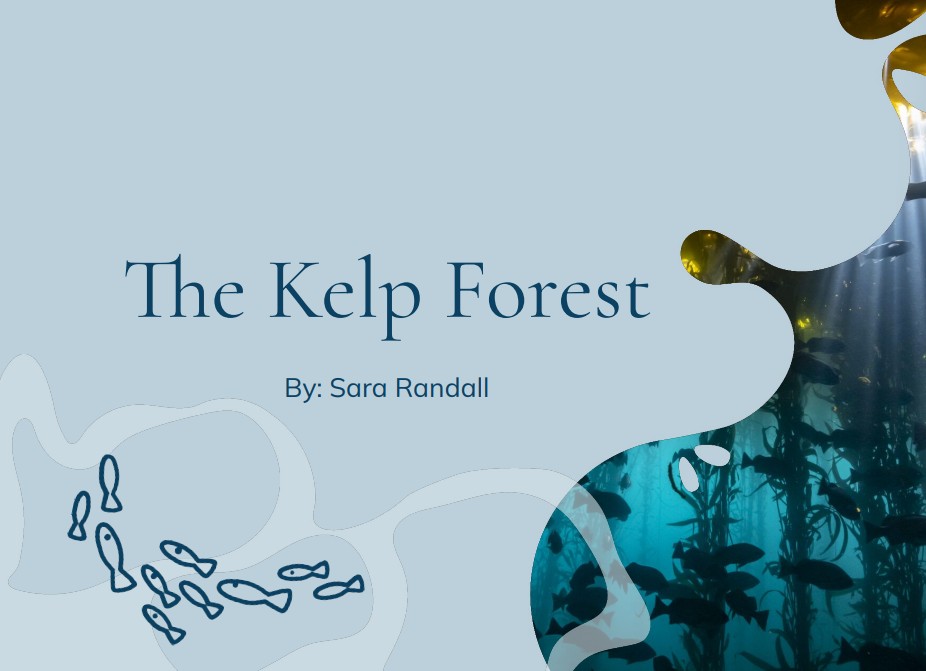

One of the presentations that stood out to me from this section was Sara Randall’s presentation on the kelp forest. In this presentation she discussed what kelp was and where it is found in the dense kelp forests in the oceans and how it is crucial to the environment. Many sea lions, seals, otters, fish, birds, and many other animals rely on kelp forests as homes, and they are also critical for commercial fisheries. Kelp is a critical part of the ecosystem and animals graze on the kelp or eat the detached fronds. Detached fronds break down into detritus that can be filtered by sea cucumbers and sponges which are eaten by predators. Kelp is a critical foundational species in this ecosystem and provides support for many other species. Another keystone species in that ecosystem is the sea otter which maintains the levels of sea urchins and keeps the urchin populations from exploding. This presentation really stood out because I had never really thought about the impact of kelp. I knew it was an important part of ocean ecosystems, but I didn’t really think about how big an impact it actually had and this presentation was really eye-opening about that.
Image By Sara Randall
“Welcome to Siwi’s New Website and Visual Identity: Siwi - Leading Expert in Water Governance.” SIWI, 13 Mar. 2023, siwi.org/latest/welcome-to-our-new-siwi-website-and-visual-identity/. Accessed 04 Nov. 2025.
2.6 Population and Sustainable Development
(Chapters 8 & 9)
The above images show my results on the homework assignments and quiz for this chapter. Here you can see I got 100% on both showing my knowledge in the material covered in this chapter, specifically with population and sustainable development.


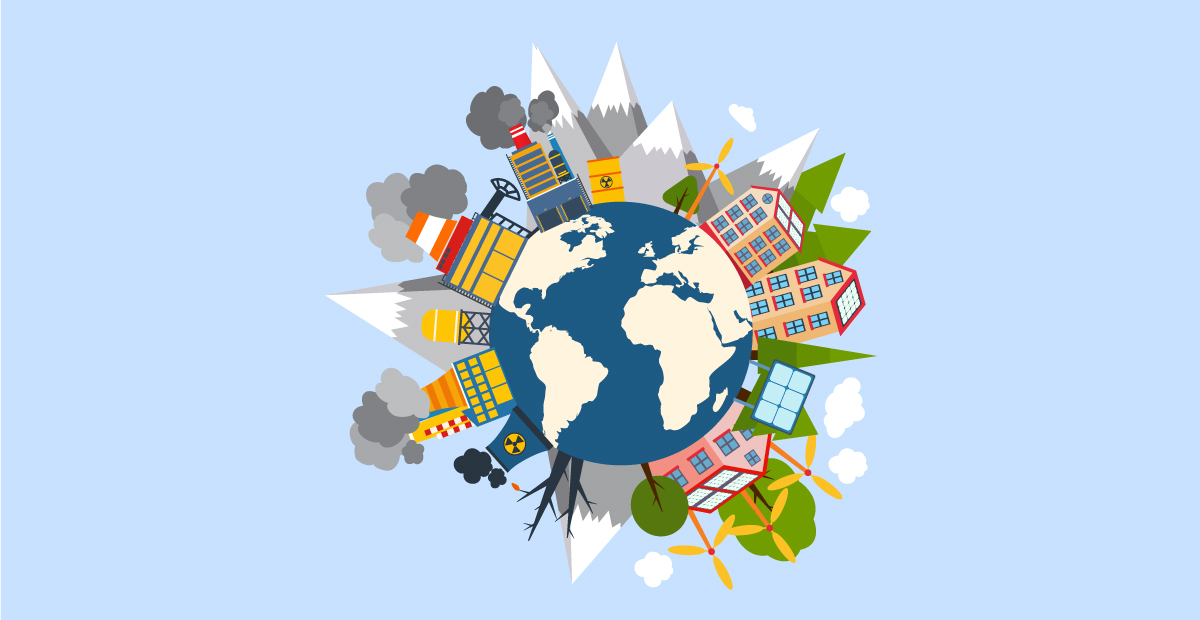

“IUSSP.” N, portal.issn.org/resource/ISSN/2704-7067. Accessed 04 Nov. 2025.
Human development pathways and urban development are driven by population dynamics. Human population has grown exponentially and has quadrupled since 1900. This puts a strain on the availability of natural resources such as food, water, land, energy, and other necessities. Economic development is also a factor in accelerating development as well as affected by it. These pressures are more concentrated in cities rather than rural areas.
When it comes to reproductive strategies there are two main types, R-Strategists and K-strategists. R-Strategists thrive in less stable environments as they are smaller in size and have a shorter lifespan. They also tend to reproduce at a young age and produce a large number of offspring and provide little to no parental care. R-strategists have large fluctuations in their population size. K-Strategists thrive in stable environments and are often larger and live longer lives. They are also older when they reproduce and have fewer offspring that they have a long and involved parental care for. K-strategists have a very stable population size. Humans have some qualities of both groups. We have the rapid growth of the r-strategists and the higher parental care for offspring later in life from the k-strategists.
One thing that makes humans unique is the ability to transform the environment to best suit them, an example of this is with the tech and agricultural revolutions. In the Neolithic Revolution humans began domesticating livestock, lived a more settled life, created a food surplus and first sustained population growth. Then came the industrial revolution where there was the introduction of fossil fuels, mechanization, urbanization, increasing productivity, and decreasing the death rates. Next was the medical/sanitation revolution where clean water, sewers, vaccines, antibiotics, and sharp morality declines were revolutionized. Then there was the green revolution that brought high-yield crops, fertilizer and irrigation, and a surge in the global food output. The final revolution discussed here was the environmental/information/technology revolution where there was a surge in environmental awareness, digital tech, family planning, and potential to decouple impact from growth.
An interesting fact about population growth is that it is much more rapid in developing countries and lower in developed countries. There is also a human population equation to track the environmental impact of a population and is represented by: environmental impact = population affluence technology. Population is the number of people, affluence is the average material/energy used per person and technology is for the pollution and resources per tech delivered or used.
There are 4 phases of demographic transition. Phase 1 is a high birth rate and a fluctuating death rate. Phase 2 is declining birth and death rates. Phase 3 is where the birthrate is approaching replacement. Finally phase 4 is a low to very low birth rate and a very low death rate. These phases occur as a country develops.
Another revolution that is meaningful is social modernization that happens as countries develop. The first big modernization is education, especially for women and girls. Another is health, which stems from better nutrition and leads to a lower infant mortality rate. There is also family planning access such as access to contraception and reproductive care. There is also the employment and income development which raises opportunity costs and leads to more jobs, micro-lending, and equity in society. Finally, there is resource management, which is sustaining common pools, protecting livelihoods, and avoiding the poverty trap.


One of the presentations that stood out to me this week was Kate's on urban sprawl and public transportation. This presentation was so engaging and interesting to learn about. Urban sprawl is the expansion of urban and commercial buildings and growing the cities and commercial areas. Urban sprawl usually happens because people want to be away from the big city with some space and land but it leads to a lot of low density development as well as increased air pollution. We want to protect our landscape and keep a lot of wild area free from urban development. This can be done by making more high density and eco friendly housing we can decrease pollution by improving the public transportation system. Improving the quality of that would lead to less individual vehicles and the pollution that comes with those. As an engineer, the design of cities is always interesting to me and looking at it from this perspective was really interesting.
Image By Kate Tyreman
A written presentation from this week was Helen Colvin's blog post on "Why Fertility Rates Fall as Women Rise". This focused on how when women gained more education and rights with their bodies, they chose to have less children and this caused a decline in the fertility rates. Lately population growth has been exponential as death rates declined and birth rates did not. An investment in educating women about reproductive health and increasing their autonomy has paid off significantly for many countries by lowering the fertility rate and giving women options. A persistently high fertility rate can lead to a poverty cycle due to a lack of resources for everyone and it also makes it more challenging to find jobs and healthcare. Education is a way of affecting population growth. This was such an interesting perspective to read about in her blog. While yes I knew that fertility ratings were dropping as women gained autonomy for their bodies, I did not make that connection to having the power to shape population growth before reading this.
2.7 Food and Pests
(Chapters 12 & 13)
The above images show my results on the homework assignments and quiz for this chapter. Here you can see I got 100% on both showing my knowledge in the material covered in this chapter, with food systems and problems, pest management, GMOs, environmental impacts from food, fertilizer, and pesticides. I did work through the quiz three times to practice and ensure full understanding of the content.


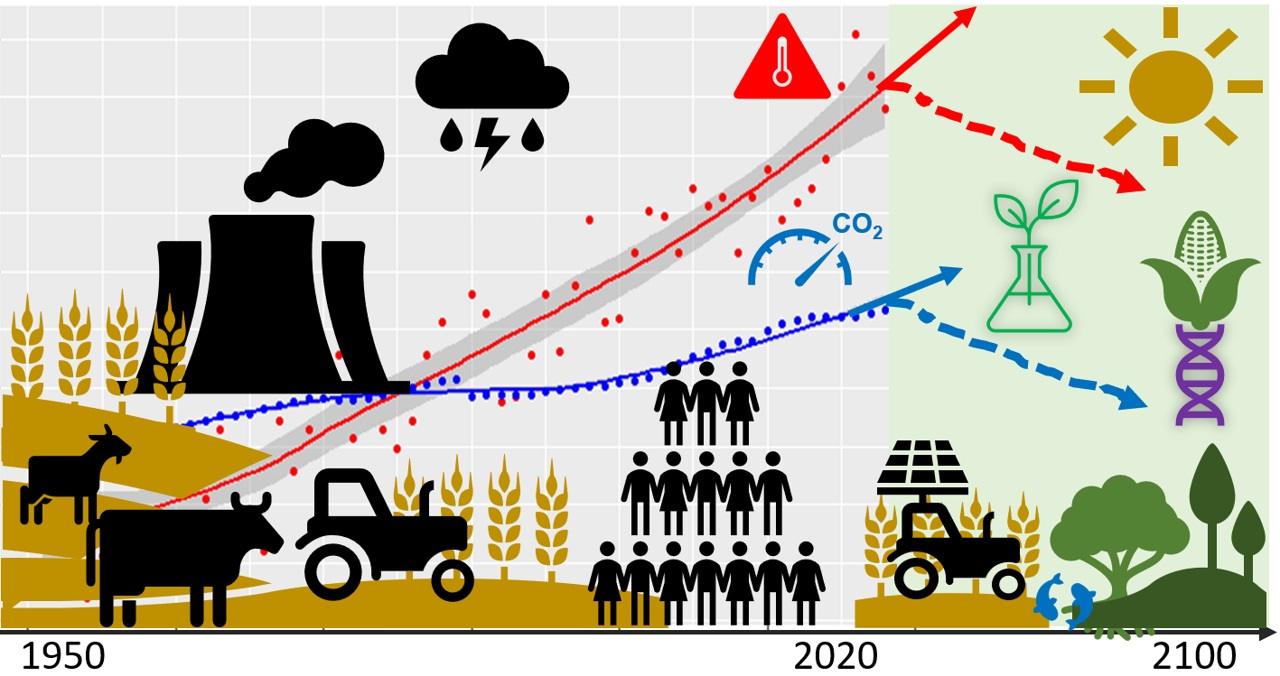

“Agriculture.” An Open Access Journal from MDPI, www.mdpi.com/journal/agriculture. Accessed 06 Nov. 2025.
It is truly amazing how much food can be taken for granted. Take a look at any meal you eat and there is food from so many different countries represented on that plate yet so many people take for granted how the food got there and where their ingredients came from. There are 8 billion people who all need to eat and so industrial agriculture dominates global trade. However, food systems require a lot of energy and rely on fossil fuels for every step from fertilizer to the harvesting machinery and transport.
To provide food for all of these people there was a switch from subsistence to industrial farming. Subsistence farming is where there are many small local farms with a diverse list of crops and a low yield. Industrial farming has larger very mechanized farms that focus on one or a couple of crops and rely heavily on fertilizers and pesticides to produce high yields. This did increase efficiency and help reduce the hunger issues, however there is a lot of soil loss, pollution, pest resistance, and a decline in biodiversity with this change.
The green revolution helped to make a lot of these changes with increasing high yield crops and irrigation and actually tripled the grain yields in many regions. It provided cheap food initially but then the prices became unstable and there was pollution from fertilizer runoff and pesticides. Then came the gene revolution and GMO crops to express certain traits to be pesticide tolerant, a higher nutrition, longer shelf life, or disease resistant. This led to even higher yields but there were also concerns with making stronger resistant plants.
While fertilizers have a lot of benefits there are some definite costs such as it releases excess nutrients into the environment leading to algal blooms and other environmental issues ad can cause pollution related problems if it gets into the water supply such as blue baby syndrome. With pesticides, excessive use leads to resistance and pesticide immune bugs, bioaccumulation, biomagnification, and declines in the bird population. This is seen with the effects of DDT which was used after WW2 and eventually got banned.
There are integrated pest management systems to help manage this by setting thresholds for pesticides, blending natural and chemical controls, crop rotation, predators, and minimal sprays to reduce chemical dependence in agriculture.
